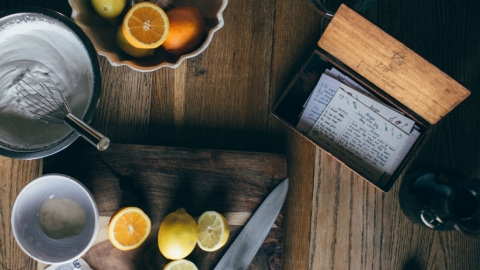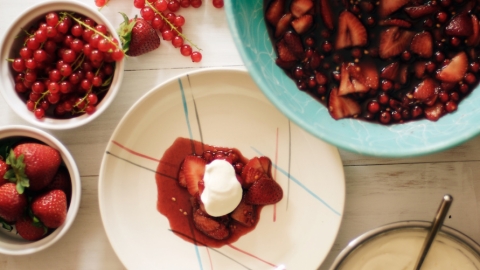In-season: Wine
Besides the type of grape, each bottle of wine has attributes that contribute to the experience of drinking it: different levels of alcohol, acidity, sweetness, tannins and aromas. These attributes play a large part when pairing wine with food or choosing which type of wine to cook with.
There are scientific reasons why wine should be a staple ingredient in your cooking arsenal, beyond the fact that it’s delicious. Wine can be crucial when baking, deglazing, braising, marinating, steaming and roasting a myriad of dishes.
A sparkling wine, like Prosecco, will bring wonderful notes of fruit and tartness to baked goods. The bubbles also provide aeration, which results in a lighter cake. When deglazing a pan after searing a cut of meat—to incorporate those flavorful caramelized bits stuck to the bottom of the pan—wine can be a better choice than stock or water, yielding richer flavors, colors and aromas to the finished pan sauce.
Wine is the optimal choice when braising or roasting tough cuts of meat, since the acidity helps break down proteins. Similarly, marinating cuts of meat with wine tenderizes them and enhances flavors. Alcohol binds with both fat and water, so wine can dissolve all the flavor compounds into the meat more effectively than a marinade without wine would. Steaming fish and vegetables with a full-bodied white wine is another great way to impart flavor, and any leftover steaming liquid can be made into a quick sauce.
Selecting:
When deglazing or braising, choose a wine that compliments the main protein or vegetable. A bold red wine or a fortified sherry/port would pair well with beef, pork, duck, lamb or fibrous greens. Chicken and fish generally pair well with dry, full-bodied white wines when steaming and deglazing, imparting the rich acidic flavor of wine without the red color and bitter tannins of red varieties.
You don’t need to buy the most expensive bottle on the shelf, but I also don’t suggest choosing the cheapest bottle. At the end of the day, if you choose a wine that you enjoy drinking, your finished dish will turn out well. Sipping on a glass of wine while you cook is half the fun, so choose accordingly.
Storing:
If you plan to consume a bottle of wine within 6 months of when you purchased it, you can store the bottle at room temperature. You can safely store wine for longer periods at temperatures between 45° and 65°. All corked bottles should be stored on their side to prevent the corks from drying out, which could lead to oxidation and loss of flavor. Once a bottle has been opened, it should be corked and placed in the refrigerator and consumed within 3 to 5 days. Sparkling wine will lose its carbonation after 1 to 3 days. Most fortified wines will last for 2 weeks in the refrigerator once opened. Boxed wines should be consumed within 2 to 3 weeks and kept in the refrigerator after opening.
Pairing:
Apples, arugula, asparagus, avocados, basil, beef, berries, black peppercorns, butter, cake, cheese, chicken, chocolate, cilantro, cinnamon, cloves, coconut, corn, cream, duck, eggs, figs, fish, garlic, grains, grapefruit, greens, honey, lamb, lemon, lettuce, lime, lobster, maple syrup, melons, milk, mint, mushrooms, mussels, nutmeg, nuts, olives, onions, oranges, oysters, parsley, pasta, pears, peppers, pork, potatoes, root vegetables, rosemary, sage, salt, scallops, squash, stone fruit, sugar, thyme, tomatoes, vanilla.
Ashley Swartzendruber is Edible Michiana’s recipe editor, stylist and photographer based in Goshen, Indiana. She can be found cooking, eating and photographing local food in her home or exploring Michiana with her family. You can find more of her photos, styling and motherhood musings on her Instagram @mywildhaven.







